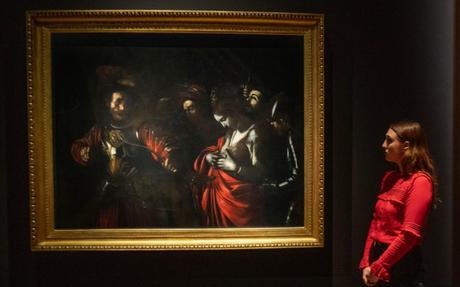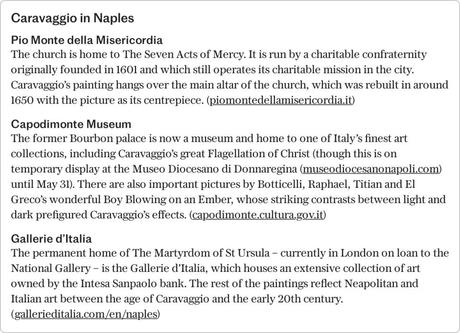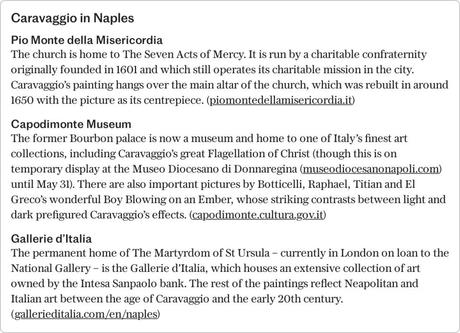
'See Naples and die.' In other words, this amazing city is so beautiful that the experience of visiting it cannot be beat. It's an old saying, probably coined by the medieval Neapolitan tourist board. But if you stop to look at the view from a terrace or balcony, you will understand what they mean. The setting is glorious. The large bay glistens in the Mediterranean sun, the long arm of the Sorrento Peninsula stretches towards Capri and to the south looms the shady part of Vesuvius. Sometimes snow-covered, sometimes smoldering, it always adds a sense of volcanic drama - and, let's face it, a slight air of menace and excitement - to the scene.
However, there is always an unfortunate truth in associating Naples with death. The city may have a glorious and breezy outlook, but it has long had a seedy side. Nowadays this is largely related to the shady practices of the Camorra - the Neapolitan mafia - which remains virtually invisible to tourists. One visitor, however, became embroiled in the low side of Naples and died shortly afterwards: the artist Caravaggio.
Busy, intense and sharp
When he arrived here from Rome in the fall of 1606, the city was in the midst of a transformation. Its economy was three times larger than Rome's and prospered under Spanish rule, attracting huge numbers of immigrants. A ban on building outside the walls meant that houses were crammed into a grid of increasingly narrow alleys, from six to seven floors - twice as high as in any other Italian city. That narrow network of streets still characterizes the historic center of what is, even today, the busiest, most intense and edgiest cities on the Italian mainland.
Caravaggio was welcomed into one of the great palaces on Via Toledo (then and now the main street of Naples). But he would also have felt completely at home in the alleys. He had already narrowly escaped from Rome after killing a love rival during a brawl (he apparently tried to cut off his genitals). It was typical of a man of unstable temperament who enjoyed the taverns and brothels of the city as much as the palazzo society of his powerful patrons. But even they couldn't protect him from a murder charge, and he had to travel south to avoid arrest.
The story continues
Naples society did not care about his reputation as a street fighter and was blinded by his talent. He was the most famous painter in Italy, a country where art was of the greatest social and spiritual importance. I think of the analogies with Diego Maradona in 1984. Another troubled and unpredictable virtuoso, he had just left Barcelona after headbutting an opponent during the cup final. But the Neapolitans didn't care; it was his football genius they longed for, and they got their reward. He soon propelled Napoli to the first Italian championship in their history and forty years later his image still dominates the city's souvenir stalls.
Four hundred years later, only three of Caravaggio's statues remain in the city. But they are three of his most brilliant paintings and they provide a fascinating insight into his time here. The very first photo he took when he arrived, The Seven Acts of Mercy, is a direct evocation of the atmosphere of the busy, threatening Neapolitan streets. Still owned by the charity that originally commissioned it, it is a claustrophobic night scene set in a pitch-black alley. A single burning torch illuminates a confusing jumble of figures. One man has fallen to the ground and another, clearly dead, is being led away. As they float above us, the Virgin and the child watch with concern.
At first glance it seems as if it must be the consequences of a street fight, such as Caravaggio had left in Rome a few weeks earlier. In reality, it is a highly unusual morality painting that brings together all seven actions - including burying the dead, clothing the nudes and sheltering the homeless - in one tableau. But because Caravaggio loved making his religious scenes feel real and relevant, it also represents the neediness and vulnerability of those who lived on the city streets.
A tour de force of light and shadow
There is also suffering and compassion in perhaps the most powerful painting he made, the Flagellation of Christ. It is a tour de force of light and shadow, of menace and tolerance, made by an artist at the height of his powers just before he left for Malta in the summer of 1607.
Two years later he was back; but his past caught up with him. As he left a brothel just off Via Toledo, his face was sliced open by an unknown assailant, probably contracted by an old enemy. In the aftermath, and no doubt suffering greatly from his wounds, he created what would become his last painting, The Martyrdom of Saint Ursula, which is also in a Neapolitan collection. This too involves a brutal attack: piercing the saint's chest with an arrow at close range. Behind her, in the shadows, a sigh of pain and horror distorting his pale features, is the face of the artist himself. It is our last glimpse of Caravaggio. When he attempted to return to Rome a few weeks later, he died of fever, probably related to his injuries.
Caravaggio had seen Naples and died. But he also adorned it with some of the most powerful and evocative works of art in history.


Essentials
Romeo Napoli (00 39 081 017 5001; theromeocollection.com) has double prices from £511 per night.
Wizz Air (wizzair.com), easyJet (easyjet.com), British Airways (ba.com) and Ryanair (ryanair.com) all fly from UK airports to Naples, with returns from £48.
The Last Caravaggio is on view at the National Gallery from April 18 to July 21. Free entry (nationalgallery.org.uk).
